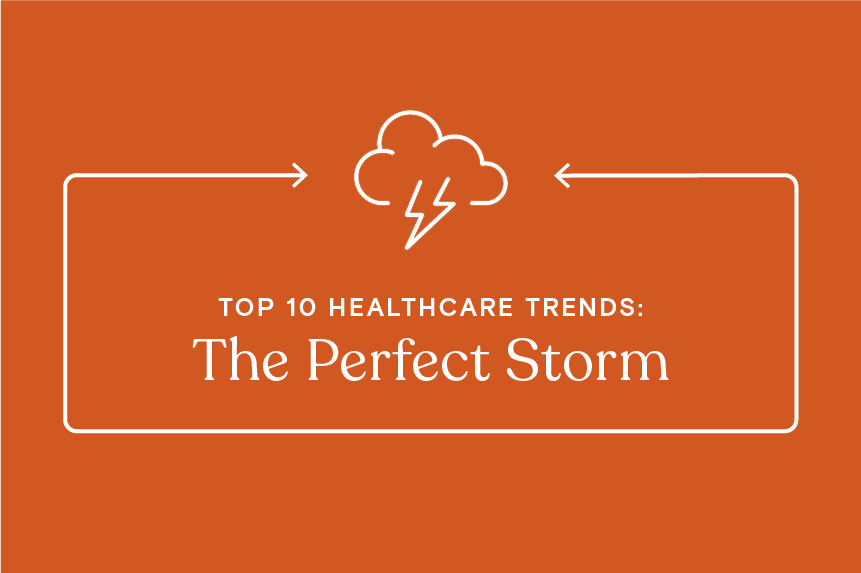Robert Musslewhite, president of Definitive Healthcare, ended this year’s Definitive LIVE! by sharing a data-driven look at the top trends in healthcare. It was one of my favorite moments of the event because his presentation showed some of the amazing insights that we can glean from the billions of data points inside our platform.
Today’s blog, however, focuses on the first three trends that Robert discussed. These trends cover the “perfect storm” of troubling issues facing healthcare providers following the unprecedented pressure placed on them by COVID-19.
These trends are:
- The harmful impact of treatment delays due to COVID-19
- The staffing shortage resulting from providers leaving the workforce
- The dramatic cost increases healthcare organizations are dealing with
The harmful impact of treatment delays due to COVID-19
The pandemic transformed healthcare in an untold number of ways. Many of which we’ve covered on this blog in the past, such as the rapid adoption of telehealth, challenges in the global supply chain, innovations in AI and more.
But one impact of COVID-19 you might not have heard about as much is how the pandemic led to significant delays in medical care. And the consequences are likely to be felt for years to come.
According to a poll from NPR, the Robert Wood Johnson Foundation and the Harvard T.H. Chan School of Public Health, “nearly 1 in 5 American households has had to delay care for serious illness” due to the coronavirus. And 76% of those households reported they had a negative health outcome as a result.
Using data from the Definitive Healthcare platform, Robert shared a few examples of the adverse impact caused by delaying care.
And many organizations and physicians across the healthcare landscape have similar perspectives. In a poll by the Primary Care Collective, 60% of physician respondents believe that their patients will experience avoidable illness due to delayed or avoided care. Many physicians fear an increased number of serious, or even fatal, health complications as a result.
Pandemic-related delays in care can pose serious long-term problems not only for patients but for facilities and healthcare providers, too.
At HFMA 2021, our SVP of Strategic Solutions, Todd Bellemare, explored the impact made by the postponement of elective surgeries on the healthcare industry. In his blog, Todd writes how a nationwide pause in elective procedures likely contributed to massive financial losses felt by healthcare organizations since 2020. One study published in the National Library of Medicine found that U.S. hospitals may have lost $16 billion a month in revenue. Using claims data, Todd estimated that it could take over two years for providers to work through their procedure backlogs.
You can learn more about the risks associated with delaying care by listening to episode four of our podcast, Definitively Speaking.
The staffing shortage resulting from providers leaving the workforce
It’s clear: the Great Resignation has come for healthcare. At the same time that healthcare organizations are dealing with increased demand for care because of delays, we have healthcare workers leaving the industry en masse.
Using ClaimsMx data, Robert shared details on the quantity and types of healthcare professionals leaving the workforce.
Fig. 1: Analysis of data from Definitive Healthcare’s ClaimsMx and PhysicianView. Based on the number of providers billing each year (by primary specialty on medical claims). Data accessed June 2022.
The staffing shortage may lead to serious problems over the next decade for patients, facilities and providers alike. We dug into the underlying causes behind the staffing shortage in a special blog series here, but to summarize:
COVID-19 exposed existing vulnerabilities in healthcare, as there weren’t enough physicians to meet patient demand.
A growing population of older adults in the U.S. is triggering demand for more specialized care providers.
Physicians are burning out due to the pandemic, long hours, changing patient expectations, insufficient salary and more.
The physician workforce is reaching retirement age. The average of a U.S. physician is 54.
Solving the physician staffing shortage will likely require a multi-faceted approach and cooperation between the federal government and healthcare providers across the nation. Currently, technologies like telemedicine and remote patient monitoring, and educational programs oriented around managing stress and mental health are making big strides in helping providers keep up with demand.
Watch our webinar on how to staff and recruit in a physician shortage to learn more about this area of the healthcare landscape and some best practices you can use to identify and recruit more qualified workers.
The dramatic cost increases healthcare organizations are dealing with
The last of these three trends is arguably a direct result of the current staffing shortage. With significantly fewer active healthcare providers, organizations have been forced to look elsewhere to fill the labor gap. And a greater demand for healthcare workers means increased costs to cover salaries and other expenses.
Hospitals and IDNs saw their contract labor expenses shoot up by more than 9% between 2019 – 2021. Many of these labor costs were driven by traveling nurse salaries, which increased by 85% during this time. According to the Los Angeles Times, certain traveling nurses enjoy compensation rates of $300 per hour. Some organizations are turning to mergers and acquisitions to manage, which we’ll cover in more detail in the second part of this blog series.
Robert also shared the impact of rising incremental costs that some healthcare organizations might not initially be aware of. Larger hospital networks tend to be better positioned to handle these cost increases and pay for traveling nurse salaries. And as these workers follow the money, we might see high numbers of nurses leave rural areas in favor of metropolitans. This could mean fewer people to provide care in rural regions, and hospitals in these locations are already facing financial crises.
Learn more
COVID-19 placed an unprecedented amount of pressure on healthcare providers. It worsened existing problems and strained healthcare workers to their breaking point. And it’s made the complex healthcare landscape even more challenging to navigate.
Healthcare commercial intelligence can help your company make sense of the changing market and make more strategic decisions. The Definitive Healthcare team reached these trends by searching through more than half a petabyte of data across our platform. If you’re interested in learning how this data can help your business grow, start a free trial today.
And stay tuned! Each week of June, we’ll be publishing another blog exploring and expanding upon the trends identified in Robert’s keynote. Next week is part two: The healthcare financial spreadsheet. See you next week!





